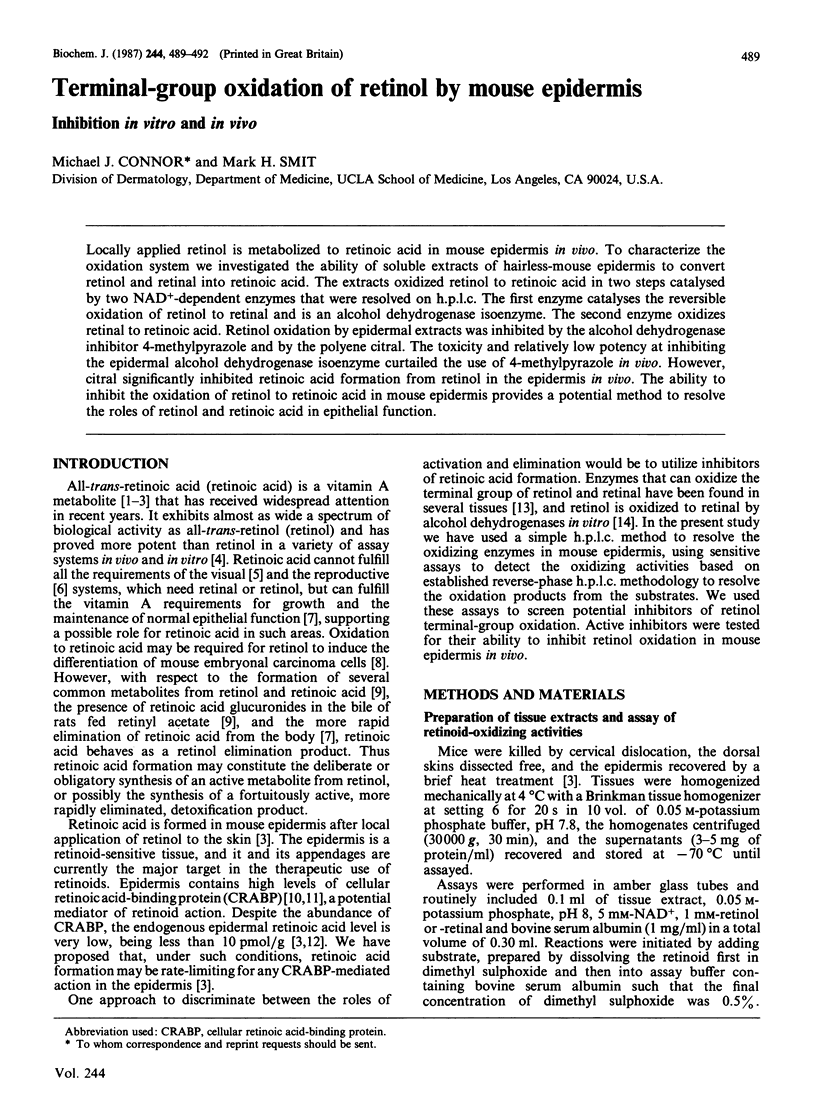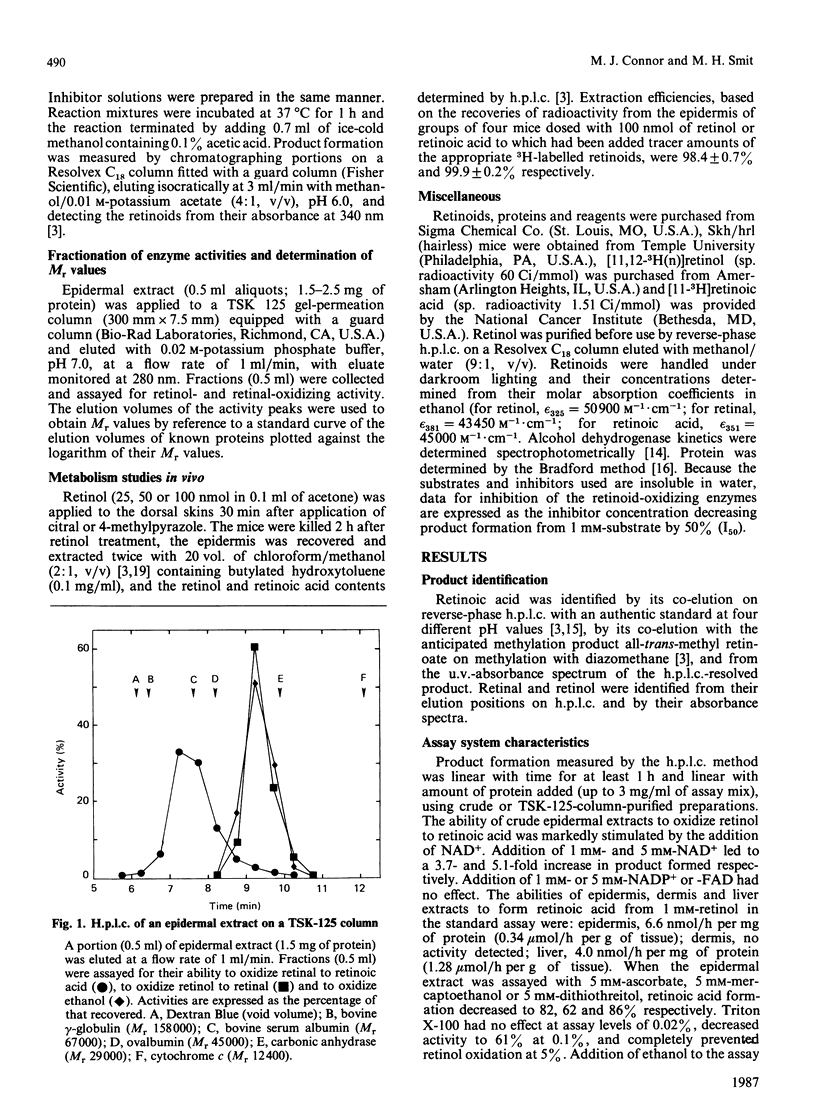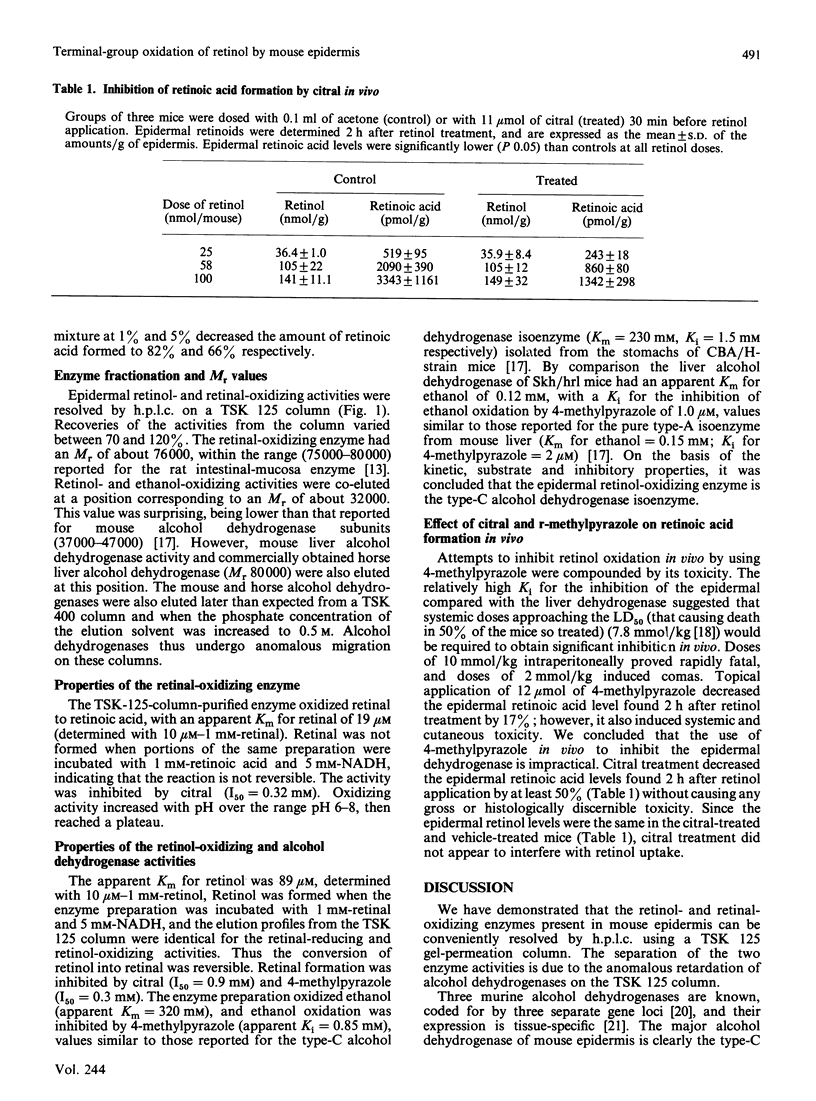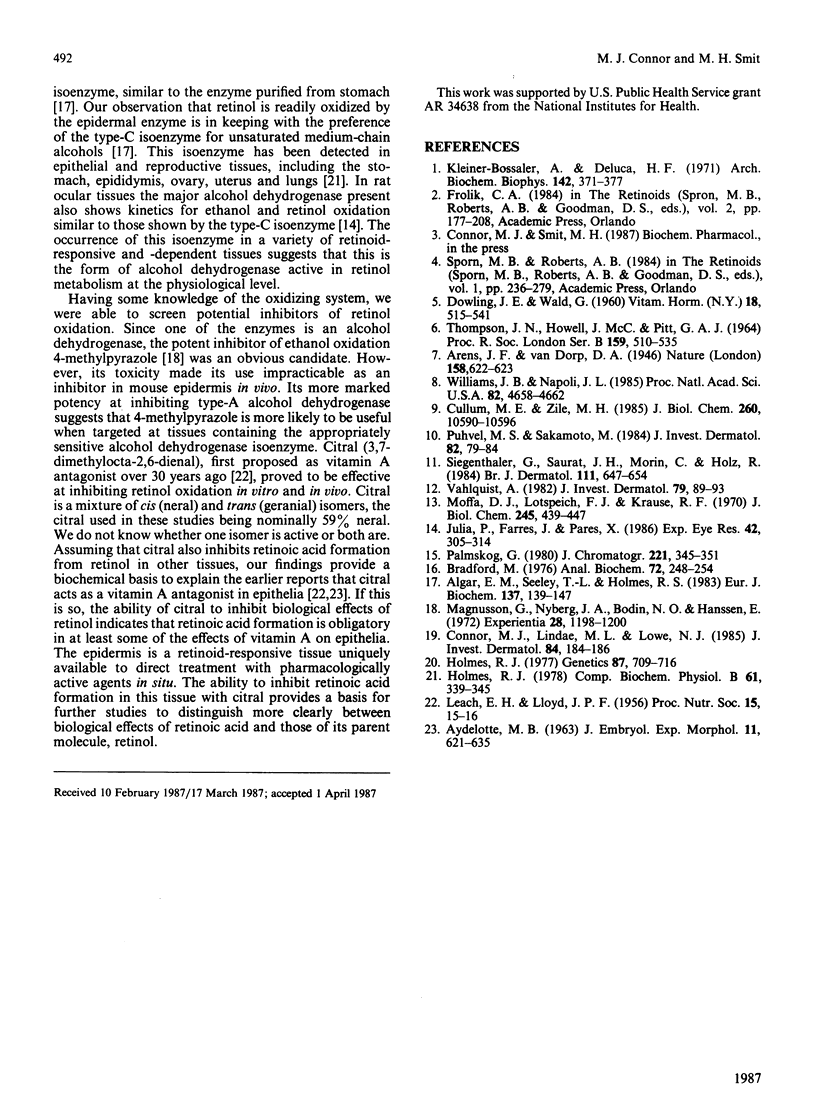Abstract
Locally applied retinol is metabolized to retinoic acid in mouse epidermis in vivo. To characterize the oxidation system we investigated the ability of soluble extracts of hairless-mouse epidermis to convert retinol and retinal into retinoic acid. The extracts oxidized retinol to retinoic acid in two steps catalysed by two NAD+-dependent enzymes that were resolved on h.p.l.c. The first enzyme catalyses the reversible oxidation of retinol to retinal and is an alcohol dehydrogenase isoenzyme. The second enzyme oxidizes retinal to retinoic acid. Retinol oxidation by epidermal extracts was inhibited by the alcohol dehydrogenase inhibitor 4-methylpyrazole and by the polyene citral. The toxicity and relatively low potency at inhibiting the epidermal alcohol dehydrogenase isoenzyme curtailed the use of 4-methylpyrazole in vivo. However, citral significantly inhibited retinoic acid formation from retinol in the epidermis in vivo. The ability to inhibit the oxidation of retinol to retinoic acid in mouse epidermis provides a potential method to resolve the roles of retinol and retinoic acid in epithelial function.
Full text
PDF



Selected References
These references are in PubMed. This may not be the complete list of references from this article.
- AYDELOTTE M. B. THE EFFECTS OF VITAMIN A AND CITRAL ON EPITHELIAL DIFFERENTIATION IN VITRO. 2. THE CHICK OESOPHAGEAL AND CORNEAL EPITHELIA AND EPIDERMIS. J Embryol Exp Morphol. 1963 Sep;11:621–635. [PubMed] [Google Scholar]
- Algar E. M., Seeley T. L., Holmes R. S. Purification and molecular properties of mouse alcohol dehydrogenase isozymes. Eur J Biochem. 1983 Dec 1;137(1-2):139–147. doi: 10.1111/j.1432-1033.1983.tb07807.x. [DOI] [PubMed] [Google Scholar]
- Bradford M. M. A rapid and sensitive method for the quantitation of microgram quantities of protein utilizing the principle of protein-dye binding. Anal Biochem. 1976 May 7;72:248–254. doi: 10.1006/abio.1976.9999. [DOI] [PubMed] [Google Scholar]
- Connor M. J., Lindae M. L., Lowe N. J. Pharmacokinetics of topically applied radiolabeled retinoids in hairless mouse epidermis and dermis after single applications. J Invest Dermatol. 1985 Mar;84(3):184–186. doi: 10.1111/1523-1747.ep12264729. [DOI] [PubMed] [Google Scholar]
- Cullum M. E., Zile M. H. Metabolism of all-trans-retinoic acid and all-trans-retinyl acetate. Demonstration of common physiological metabolites in rat small intestinal mucosa and circulation. J Biol Chem. 1985 Sep 5;260(19):10590–10596. [PubMed] [Google Scholar]
- DOWLING J. E., WALD G. The role of vitamin A acid. Vitam Horm. 1960;18:515–541. doi: 10.1016/s0083-6729(08)60878-x. [DOI] [PubMed] [Google Scholar]
- Holmes R. S. Electrophoretic analyses of alcohol dehydrogenase, aldehyde dehydrogenase, aldehyde oxidase, sorbitol dehydrogenase and xanthine oxidase from mouse tissues. Comp Biochem Physiol B. 1978;61(3):339–346. doi: 10.1016/0305-0491(78)90134-7. [DOI] [PubMed] [Google Scholar]
- Holmes R. S. The genetics of alpha-hydroxyacid oxidase and alcohol dehydrogenase in the mouse: evidence for multiple gene loci and linkage between Hao-2 and Adh-3. Genetics. 1977 Dec;87(4):709–716. doi: 10.1093/genetics/87.4.709. [DOI] [PMC free article] [PubMed] [Google Scholar]
- Julià P., Farrés J., Parés X. Ocular alcohol dehydrogenase in the rat: regional distribution and kinetics of the ADH-1 isoenzyme with retinol and retinal. Exp Eye Res. 1986 Apr;42(4):305–314. doi: 10.1016/0014-4835(86)90023-0. [DOI] [PubMed] [Google Scholar]
- Kleiner-Bössaler A., Deluca H. F. Formation of retinoic acid from retinol in the kidney. Arch Biochem Biophys. 1971 Jan;142(1):371–377. doi: 10.1016/0003-9861(71)90295-5. [DOI] [PubMed] [Google Scholar]
- Magnusson G., Nyberg J. A., Bodin N. O., Hansson E. Toxicity of pyrazole and 4-methylpyrazole in mice and rats. Experientia. 1972 Oct 15;28(10):1198–1200. doi: 10.1007/BF01946169. [DOI] [PubMed] [Google Scholar]
- Moffa D. J., Lotspeich F. J., Krause R. F. Preparation and properties of retinal-oxidizing enzyme from rat intestinal mucosa. J Biol Chem. 1970 Jan 25;245(2):439–447. [PubMed] [Google Scholar]
- Palmskog G. Determination of plasma levels of two aromatic retinoic acid analogues with antipsoriatic activity by high-performance liquid chromatography. J Chromatogr. 1980 Dec 12;221(2):345–351. doi: 10.1016/s0378-4347(00)84320-0. [DOI] [PubMed] [Google Scholar]
- Puhvel S. M., Sakamoto M. Cellular retinoic acid-binding proteins in human epidermis and sebaceous follicles. J Invest Dermatol. 1984 Jan;82(1):79–84. doi: 10.1111/1523-1747.ep12259164. [DOI] [PubMed] [Google Scholar]
- Siegenthaler G., Saurat J. H., Morin C., Hotz R. Cellular retinol- and retinoic acid-binding proteins in the epidermis and dermis of normal human skin. Br J Dermatol. 1984 Dec;111(6):647–654. doi: 10.1111/j.1365-2133.1984.tb14147.x. [DOI] [PubMed] [Google Scholar]
- THOMPSON J. N., HOWELL J. M., PITT G. A. VITAMIN A AND REPRODUCTION IN RATS. Proc R Soc Lond B Biol Sci. 1964 Feb 18;159:510–535. doi: 10.1098/rspb.1964.0017. [DOI] [PubMed] [Google Scholar]
- Vahlquist A. Vitamin A in human skin: I. detection and identification of retinoids in normal epidermis. J Invest Dermatol. 1982 Aug;79(2):89–93. doi: 10.1111/1523-1747.ep12500032. [DOI] [PubMed] [Google Scholar]
- Williams J. B., Napoli J. L. Metabolism of retinoic acid and retinol during differentiation of F9 embryonal carcinoma cells. Proc Natl Acad Sci U S A. 1985 Jul;82(14):4658–4662. doi: 10.1073/pnas.82.14.4658. [DOI] [PMC free article] [PubMed] [Google Scholar]


